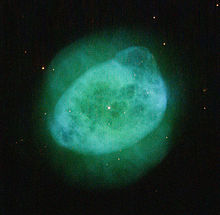IC 289
Appearance
This article needs additional citations for verification. (April 2017) |
| Nebula | |
|---|---|
 As seen by Hubble | |
| Observation data: J2000.0 epoch | |
| Right ascension | 03h 10m 19.30s |
| Declination | +61° 19′ 01.00″ |
| Constellation | Cassiopeia |
| Designations | IRAS 03062+6107, 2MASS J03101930+6119009, ARO 86, Hb 1, VV 9, RL 67, Lan 496, NSV 1056, GSC2 N313033135782 |
IC 289 is a planetary nebula in the constellation Cassiopeia.[1] It was discovered by Lewis Swift in early September 1888. It lies close to the 10th magnitude star BD +60° 0631. N.J. Martin described IC 289 as "A nice, faint round planet like planetary nebula. The uniform oval disc shows some irregularity in brightness but is not obviously brighter at the edge."[citation needed]
